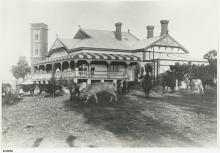Mount Barker
The Salvation Boys' Home at Mount Barker accommodated both Indigenous and non-Indigenous children. There were many concerns about the standard of care at the home. In 1959 a government inspector reported on the use of a "dark punishment room" used for isolating and punishing children. The existence of this room was confirmed only in the 1970s. Government records indicate other allegations of abuse were made by former residents throughout the 1960s to 1980s. From 2004 to 2008, the Children in State Care Commission of Inquiry received personal testimonies from 18 former residents who had suffered abuse while at Mount Barker .
0Established 1945 by the Salvation Army, closed in 1982.
Salvation Army Boys' HomeKaren George and Gary George, The Salvation Army Boys' Home, Mount Barker (1945 - 1982) (10 February 2015) Find & Connect https://www.findandconnect.gov.au/ref/sa/biogs/SE00132b.htm
SAUKARIA Cultural Centre
http://www.ukaria.com/Peramangk-People
Robin Coles and Richard Hunter, The Ochre Warriors: Peramangk Culture and Rock Art In the Mount Lofty Ranges (Axiom, 2010).
Ngurlinjeri people of the Peramangk nation Peramangk language Nunga Anangu in Central Australia SAThey used to lock us up in a little room like a cell and keep us on bread and water for a week if you played up too much. Stand us on a cement block outside in the rain with raincoats on if you got into trouble - for a month, after school, during playtime (p. 139).
Confidential evidence 358b, South Australia: man removed as a baby in the 1950s; first placed at Koonibba Mission, then a Salvation Army Boys' Home where he experienced the above punishments, then on to reform school and prison.
Human Rights and Equal Opportunity Commission, Bringing them Home: National Inquiry into the Separation of Aboriginal and Torres Strait islander Children from Their Families (1997)
Birth Confidential evidence 358b
Salvation Army Boys' Home, ca. 1905
